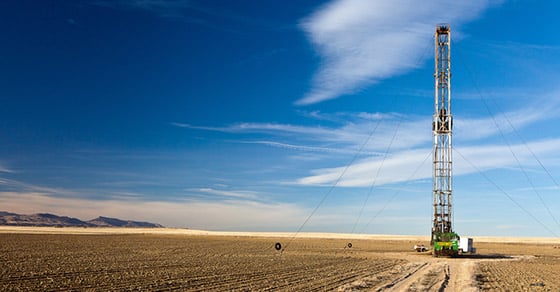The US is well on its way to energy independence as mining unconventional shale resources via hydraulic fracturing has become increasingly advanced, allowing producers to reduce costs and recover more from shale formations.
A growing trend has been seeing increased adoption in recent years, “re-revolutionizing” the shale industry according to some; the practice of “refracturing,” or “refracking,” is breathing new life into old wells and proving to be a valuable tool for the industry, both economically and environmentally.
Obtaining the frac sand used in the hydraulic fracturing process, however, could be a potential challenge as drillers struggle to keep the economics under control amidst an evolving industry.
What is Refracking?
The past decade has been a whirlwind for the oil and gas industry; widespread adoption of the hydraulic fracturing technique revolutionized the production of hydrocarbons, allowing drillers to access resources that were previously uneconomic, opening up a new wave of production.
As this technology improved and eventually joined forces with horizontal drilling techniques, the industry was in a constant state of advancement. Add to this the growing understanding of shale plays and well performance, and newer wells quickly became far superior to those drilled at the onset of the shale revolution. This, in combination with low (albeit recovering) oil prices, lead some producers to take another look at these older wells, and thus, “refracking” was born.
A variety of technologies are available for refracking, but they all serve one purpose: to revive an existing well through restimulation in an effort to recover hydrocarbons that were previously inaccessible due to the limited technology available at the time of initial drilling. In short, refracking applies new technologies to old wells to boost recovery.
Why Refracking is Becoming So Popular
Refracturing is far from a new technique, but its application to the newly employed, multi-stage horizontal wells has brought it to the forefront of the industry in recent years, particularly as a way to bring in money despite low margins.
According to Bloomberg, this practice looks to be solving the industry’s Achilles heal – the short life span of wells – production of which, drastically drops off after initial drilling. According to an article in the Bismarck Tribune, Justin Kringstad, the director of the North Dakota Pipeline Authority says the industry suspects that wells are recovering as little as 5 – 15% of what lies below.
Mike Vincent, a well-completion engineer, is quoted by Bloomberg as claiming that refracking has the potential to boost oil recovery by more than 60% and can even increase the well’s estimate of reserves. A study of 80 Bakken wells carried out by Bloomberg showed production of the refractured wells was 30% higher in the month after refracking than it was after original completion.
In addition to increasing well life and boosting recoveries, refracking also offers some other economic and environmental benefits that have pushed its adoption.
Economic Benefits:
Significantly Lower Costs
The establishment of a new well is incredibly costly; the potential to simply revisit an existing well where infrastructure is already in place allows for substantially reduced costs – as much as 75% when compared to the cost of a new horizontal well.
Environmental Benefits:
Reduced Environmental Impact
The environmental impact is also greatly reduced because all the necessary infrastructure is already in place.
A recent analysis of data from 23 years and 20,000 wells conducted by Middleton et al. is confirming these findings. The research group found refracturing, or the improvement of tail processing, as they refer to it, to be a highly promising endeavor in terms of increasing production while reducing environmental footprint.
It’s important to note that not all wells are suitable for refracking – wells must meet a few requirements to be eligible, but there are still plenty of promising candidates out there – 50,000 wells in the US according to Halliburton.
A Changing Industry
The shale industry has undergone significant changes in recent years between boom and bust cycles and technological advancements. While the refracturing trend is still largely in its infancy, it’s clear that it holds the potential to be a major economic opportunity for the industry in a time when margins are thin and environmental regulations continue to tighten.
Frac Sand: An Industry Challenge
One potential challenge to the refracking trend, at least in the near-term, could be the provision of frac sand. Interestingly, the refracking revolution comes at a time when another trend is taking hold in the industry: in-basin frac sand.
Frac sand producers are using more sand in the hydraulic fracturing process than ever before. They are also increasingly relying less on the premium Northern White sand that must be brought in via rail from the Midwest, and more on lower quality sources of local sand that can be trucked in at substantially lower costs. Despite frac sand mines and drying plants cropping up all over the US and particularly in the South, the infrastructure to support local sand sources has not yet caught up to the demand.
Between the exponentially increasing demand for frac sand and challenges in logistics, drillers are experiencing a bit of a strain in trying to get frac sand to where it’s needed while keeping costs down.
Conclusion
Despite the deluge of new production at the onset of the shale revolution afforded by hydraulic fracturing, drillers were often left disappointed with recovery rates when they knew there was so much more below their feet. The application of refracking horizontal wells, however, has allowed these previously inaccessible resources to be recovered at a lesser cost and with a lower environmental footprint. The refracking trend looks to be taking hold, bolstering the shale industry despite challenging times, but obtaining enough frac sand could be a potential challenge in the near term.
FEECO provides the industry’s best rotary dryers for drying frac sand. Our dryers offer a high capacity processing solution built for lasting and efficient drying. For more information on our frac sand dryers, contact us today.



